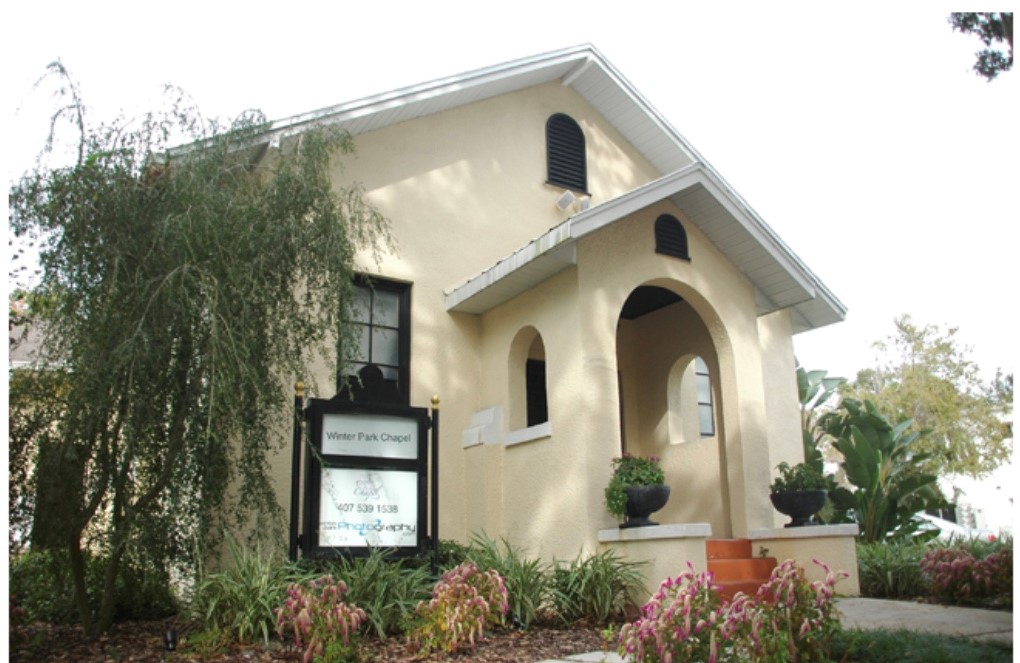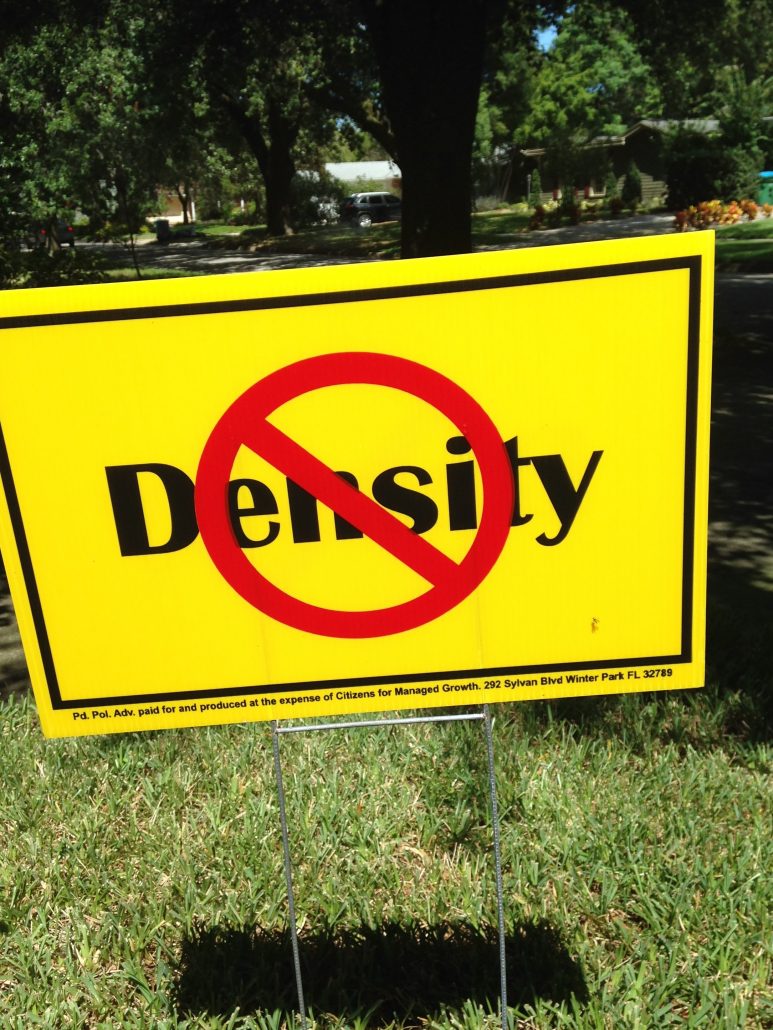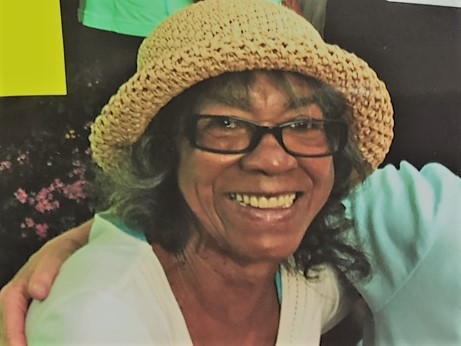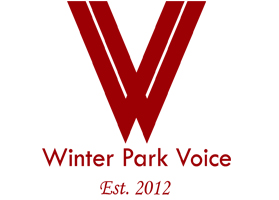by Anne Mooney | Apr 13, 2018 | Headline, Historic Preservation, Opinion
Heaven on Wheels
Grant Chapel Hijacked Again
Editor's Note: Articles written by citizens reflect their own opinions and not the views of the Winter Park Voice.
Guest Columnist Jan Hommel

Dan Bellows has hijacked Grant Chapel once again.
Hannibal Square developer Dan Bellows has managed to obtain the City’s okay to operate a commercial enterprise in a building zoned O-2 (office). Since the matter has not been before either the Planning & Zoning Board or the City Commission, one can only conclude the approval came through City staff.
Grant Chapel Served West Side Community Since 1935
According to the Friends of Casa Feliz website, Grant Chapel was built on Winter Park’s West Side in 1935 and served as a house of worship for the predominantly African American population for almost 70 years. When the congregation outgrew its location, Bellows recognized the development potential of its prime Hannibal Square location and purchased the building.
https://friendsofcasafeliz.wordpress.com/tag/winter-park-history/
For a few years, Bellows rented the property to Suzanne and Steve Graffham, who operated it as the “Winter Park Wedding Chapel.” They ran a photo studio and used the chapel primarily for destination weddings.
Grant Chapel on the Move
In 2013, Bellows struck a deal with the City to move Grant Chapel from its original home on New England to its present site on Lyman Avenue close to the railroad tracks and across from the Farmer’s Market. At the time, Bellows assured the Commission that if they up-zoned the Lyman Ave. Chapel property from R-1 to O-2 (office), he would place the Chapel on the Historic Register as soon as the move was completed.
Grant Chapel Headed for Historic Preservation?
Delighted, the City Commission approved the Chapel’s R-1 zoning change to O-2. Its use as a wedding chapel and photo studio fit neatly into O-2 zoning. It looked like another historic Winter Park property was saved from the wrecking ball in the “move-it-or-lose-it” historic preservation strategy of those days.
Or Not
A funny thing happened on the way to the Historic Preservation Board, however. After its December 2013 move, the chapel was remodeled to include the addition of a basement with two staircases descending from the front façade. The landscaping on Lyman featured elaborate hardscaping, in stark contrast to the humble leafy lot where the chapel originally stood. By the time Bellows’ application reached the Historic Preservation Board (HBP), the board refused to add Grant Chapel to the Historic Registry.
Another ‘Golden Egg in an Unguarded Nest’
And once a listing in the historic registry was no longer a consideration, Bellows made even more changes to the building. Meanwhile, the historic landmark has been lost.
No More Grant Chapel
Now, Grant Chapel has been rebranded as Hudson’s Chapel & Cellar in Hannibal Square. This facility is prominently advertised in the newspaper and on its website as a “stunning venue for any event.” The website proclaims Hudson’s is suitable for parties of up to 60 guests, with catered food and beverages. While wedding ceremonies are welcome in the Chapel, Hudson’s promotes itself as perfect for all types of events — holiday parties, corporate events, birthday celebrations, etc.
But, wait. Hudson’s Chapel and Cellar, greater than its original size and with no additional parking, is still zoned O-2.
According to the City’s Land Development Code, (Sec. 58-73,) O-2 zoning means offices. There is a very short list of permitted uses. When the Commission approved the O-2 zoning, they were given to understand that the intended use of Grant Chapel was as a Wedding Chapel and photography business – two uses that fit neatly within 0-2 zoning.
Disturbing the Neighbors?
Types of business that are not permitted in buildings zoned O-2, because of the potential to disturb the neighbors, are “private and semi-private clubs, lodges, halls, and/or social centers and restaurants or lounges.”
Comp Plan Conflict – No Commercial on West Lyman
City approval of Mr. Bellows’ use of Grant Chapel as an event and party venue in O-2 zoning clearly requires up-zoning to C-1 (commercial). Hudson’s is now a Commercial Establishment . . . on West Lyman Avenue, which the Comp Plan says is to remain forever residential.
“But Everyone Knew. . .”
City Manager Randy Knight stated the Commission knew they were approving a party and event venue when they gave approval for the then-Winter Park Wedding Chapel to operate from the Lyman Avenue location as part of the O-2 zoning process.
Even Though There Was No Public Notice
Yet, the Winter Park Wedding Chapel did not operate as a party and event venue at either the New England or Lyman Avenue location. There is no evidence of a publicly noticed discussion of Bellows’ intent to turn Grant Chapel into a party and event venue. If the Commission intended for Bellows to operate a party and event center, why was the property not up-zoned to C-1?
Parking Rears Its Ugly Head . . . Again
Hudson’s Chapel already has minimal parking – parking that any city official, elected or otherwise, who has a critical eye might find inadequate for an event venue with a capacity of up to 60 guests. . .parking that will be further eroded by Bellows’ upcoming development of the Blake Yard property.
Bellows has hijacked Grant Chapel once. Shame on him. If we let him hijack it again, shame on us.
mayorandcommissioners@cityofwinterpark.org
Contact your elected representatives to insist that the use of Grant Chapel remain consistent with its 0-2 zoning.
Jan Hommel is a resident of the West Side neighborhood of Winter Park.
To comment or read comments from others, click here →
by Anne Mooney | Apr 8, 2018 | Headline, Opinion, Zoning and Development
Those Yellow Signs – They’re Back!
Neighbors Protest Aloma Townhome Development
Editor's Note: Articles written by citizens reflect their own opinions and not the views of the Winter Park Voice.
Guest Columnist Beth Hall
 The city Commission is now all that stands between a group of Osceola/Lakeview Planning District residents and a development proposal which threatens to destroy the single family character of their neighborhood, as well as that of a block on the north side of Aloma between Phelps and Lakemont Avenues.
The city Commission is now all that stands between a group of Osceola/Lakeview Planning District residents and a development proposal which threatens to destroy the single family character of their neighborhood, as well as that of a block on the north side of Aloma between Phelps and Lakemont Avenues.
No Density Signs are Back
City Planning staff and the Planning and Zoning Board have given the high-density, 18 town home project a big thumbs up, despite the fact that it will strip four of the five lots of their single family R-1A status. Residents adjacent to and directly behind the project are up in arms.
Planning Staff Recommends PURD
City Planning staff has worked with the applicant, Ansaka LLC, on the project for close to 18 months and are now recommending approval. The project takes the maximum conceivable density under the Planned Unit Residential Development (PURD) and R-3 zoning classifications, then adds four additional housing units.
Comp Plan Provides for Preservation of Single Family Zoning
The Comprehensive Plan provides that single family homes in this district are to be “preserved.” City planning staff maintains that this is true of 98 percent of the planning district, but not on this part of Aloma. The growing number of yellow “No Density” signs sprouting along Aloma suggests that prospective neighbors beg to differ.
Ironically, during the same 18-month period the Planning Staff was working with the applicant, the City’s Comprehensive Plan was undergoing its periodic revision process. Despite countless staff hours and numerous community meetings, including Commission meetings, the Comp Plan still calls for the single-family R-1A designation of these parcels west of the corner of Lakemont and Aloma to remain undisturbed.
P&Z Grants Approval December 2017
Planning and Zoning took up Ansaka’s application on December 5, 2017. They approved it over the objections of the residents who appeared and spoke in opposition.
P&Z recommended the applicant hold a community meeting to discuss an appropriate “buffer” between the project and the adjacent single family homes to the north and west of the micro-community before the project went to public hearing at the January 6, 2018, Commission meeting.
Ansaka Slows Down Application Process
Ansaka skipped the January 6 Commission meeting, and finally held a community meeting on March 1, 2018. It is unclear how attendees were notified of the meeting. The applicant chose to postpone the public hearing until March 26, 2018.
City Staff Hits Speed Bump
Then, a glitch in the City’s public notification process necessitated a delay for two more weeks, until Monday, April 9, because of the City’s inability to verify that it had provided adequate public notice in all its required forms, including publication.
Speed Bump Slows Ansaka
The Applicant made clear his intention to proceed on March 26, but was unsuccessful. The project was pulled from the March 26 agenda and rescheduled to April 9. The intervening two weeks have seen a surge in awareness of the project throughout the neighborhood and throughout the City.
Neighbors Ask Commission to Step into the Breach
At this moment, residents of the neighborhood near the project are holding out hope that the city Commission will give their already established property rights priority over those of a developer who bought land speculating that he could rezone it, change the future land use map, and amend our Comprehensive Plan.
Who will prevail?
To comment or read comments from others, click here →
by Anne Mooney | Apr 3, 2018 | Headline, Opinion, Zoning and Development
What to do about Winter Park’s Infestation of Carpetbaggers?
Open Letter to the Mayor, Commissioners and my Winter Park Neighbors
Editor's Note: Articles written by citizens reflect their own opinions and not the views of the Winter Park Voice.
Guest Columnist Todd C. Weaver
 Population Threshold is a topic that rarely comes up in conversations about public policy, but it should, and particularly with regard to the proposed 18-unit Planned Urban Residential Development (PURD) on Aloma between Lakemont and Phelps.
Population Threshold is a topic that rarely comes up in conversations about public policy, but it should, and particularly with regard to the proposed 18-unit Planned Urban Residential Development (PURD) on Aloma between Lakemont and Phelps.
What is Population Threshold?
A Population Threshold is the point at which the rate of increase of the per capita cost of public services is more rapid than the rate of increase in population. You’ve likely heard the false narrative that increasing the size of our tax base is good for Winter Park.
In the long run, nothing could be further from the truth.
Taxes Go Up as Thresholds Are Crossed
As population density increases, the cost per capita for public services increases at a faster rate than the population, and any increase in housing density never pays for itself. It gets paid for by increasing taxes on the entire population. Likewise, chances that an increase in the commercial tax base pays for itself are slim to none.
Winter Park boasts a fine staff of experts that oversees the functionality of our city services. These people can tell you that at certain thresholds, city service costs, which are funded by taxpayer dollars, must accommodate increases in development at certain trigger points or “thresholds.”
Hundreds of Miles of Buried Pipe and Conduit
Staff responsible for public works and utilities can tell you that we have hundreds of miles of piping and conduits buried under the City to handle sewage transfer, storm water and potable water. We also have a plan in place to use recycled water for irrigation, requiring more miles of underground piping. The same is true for the electric undergrounding effort, currently underway.
At some population threshold, the carrying capacity (size) of these pipes and conduits must be increased, at a substantial cost to present and future residents and businesses. Streets must be dug up, traffic rerouted, expensive horizontal drilling where traffic cannot be practically diverted, temporary diversions of flows during construction, additional pumping and lift stations, water treatment facilities, increased electric substation equipment . . . and the list goes on.
Public Safety Costs Increase
The cost of Public Safety rises commensurately. The frequency of police calls from high-density, multifamily developments is far greater than those from single family homes and most businesses. This requires increased patrols, call answering and staff. We need more manpower and more sophisticated firefighting and EMT equipment to handle high-density structures as development and population increase.
Traffic Increases
Increased density brings increased automobile traffic, adding to the nutrient loads draining into our lakes. We must compensate for the increased nutrient load in our waterways with expensive herbicides, increased labor and expensive aquatic equipment to handle tussocks, algae blooms and dredging exacerbated by development. Every time additional pavement or impervious surface is laid, storm water runoff increases, putting us closer to another threshold.
High Density = Variances
The development at Aloma and Lakemont is all too common a scenario. Despite having a Comprehensive Plan and zoning codes in place, a small number of players, who are well aware of the limitations of land use imposed by City regulations, now expect the Planning & Zoning Board and the Commission to roll over and grant their claims for significant variances, zoning changes and other non-compliant requests.
The developer, ANSAKA, LLC, bought four single family lots and one office lot. At the April 9 Commission meeting, the City will be asked to rezone them all — on the primary east-west corridor through the City. When combined, the lots do not meet the 2-acre minimum required by code to build such a development.
Profit Is Not Dependent on Zoning Changes
I’ve developed multiple commercial and residential properties in several Florida counties over the past 20 years. Never once did my company believe it had the right to ask for any variance to local or State codes. We were happy to have the assistance of municipal and county staff to guide us through the maze, and were content with a reasonable profit in every case.
Developers have a right to make a profit — that’s not the argument. What we have now in Winter Park, however, are a few developers who think it’s their right to maximize profits at the expense of Winter Park residents and businesses, and at the expense of our standard of living. These firms are like the carpetbaggers of the Reconstruction South, arriving with an empty bag, staying long enough to fill the bag with money, then leaving the townsfolk to deal with the resulting mess.
Asking Everyone to Use the Same Playbook
All we ask is that everyone play by the same rules — the rules we all agreed to in our Comprehensive Plan and zoning codes.
I respectfully ask the Commission to consider the above facts and logic and do the right thing by holding the line on our Comp Plan and zoning codes in the interest of your current and future constituents.
Sincerely,
Todd Weaver
Todd Weaver is a 22-year resident of Winter Park, and a 45-year resident of central Florida.
After graduating from UCF’s College of Engineering, Weaver spent much of 30 years as an aerospace & mechanical design engineer. He also attended UF Gainesville, taking graduate courses in biochemistry, veterinary medicine and other life sciences. He holds a Florida General Contractor license and has developed several residential and commercial properties.
Three years ago, Weaver and two partners founded a Winter Park-based company, TruGrit Traction, which has designed and patented a new type of wheel for underground pipe-inspection robots. Weaver’s company supplies Winter Park’s Water & Wastewater Utilities Department with wheels for their camera robots, at no charge to the city. TruGrit Traction proudly engineers, manufactures and assembles all products in the USA, with sales in 50 states, Canada and the European Union.
To comment or read comments from others, click here →
by Anne Mooney | Mar 30, 2018 | Headline, News
Lurline Fletcher - October 4, 1943 – March 24, 2018
Winter Park Has Lost a Treasure

Winter Park lost one of its own when Lurline Daniels Fletcher passed away the night of Saturday, March 24, 2018. Ms. Fletcher, who died of natural causes, was surrounded by her family. She was 74.
Born October 4, 1943, to Hurley Daniels and Hattie Magee Daniels in Foxworth, Mississippi, Lurline moved with her family to Winter Park at the age of five. She was married to Robert Lloyd Fletcher, who died in 1978. She is survived by two sisters, Arzolia MacDonald and Hurley Mae Donaldson and a brother-in-law, James Donaldson. A step brother, Arthur Hall, predeceased her.
Lurline is also survived by three children, Kem Fletcher Jones, Nanette Walthour and Vanallen Berry. She also had nine grandchildren, 26 great grandchildren and two great-great grandchildren.
Lurline worked for many years at the Welbourne Avenue Nursery and Kindergarten as a teacher’s aide. She then attended nursing school, which she completed in the late 1970s, and subsequently went to work the Central Florida Kidney Center as a transporter.
Lurline was an active member of Mt. Moriah Missionary Baptist Church for more than 50 years. She loved to travel and particularly enjoyed cruises. She traveled to Hawaii and the Caribbean, among many other places. Lurline’s daughter Nanette said, “After her children were grown, her life consisted of helping others and traveling.”
Her children describe her as a wicked, exacting card player. “She loved to play cards,” said daughter Kem. “She always knew every card that had been played, and she never let us get away with anything.”
Most Winter Parkers will remember Lurline as a strong voice at City Hall, speaking out for the preservation of the character of Winter Park’s West Side. “Commission meetings will never be the same,” said Sally Flynn. “There never will be another Lurline Fletcher.”
Charley Williams observed that when Lurline was asked to quiet down, she just spoke louder. “I hope Winter Parkers will honor Lurline’s memory by always showing up, like she did,” said Williams, “wearing shades and their very best hat.”
Services will be held Monday, April 2, at 11:00 a.m. at Mt. Moriah Missionary Baptist Church at the corner of Pennsylvania and Lyman. The service will be conducted by Pastor Weaver Blondin. There will be a viewing at the church from 9:00 until 10:30 a.m. Lurline will be laid to rest at Washington Park Cemetery on Brewton Blvd. in Orlando. Tillman Funeral Home, 620 E. York St., Monticello FL 32344, is handling arrangements.
When asked for a word that described Lurline’s life, her children responded.
Kem: “Tenacity”
Nanette: “Family”
Vanallen: “Loving and caring”
Lurline’s legacy of civic engagement is as much a hallmark of Winter Park as are the live oaks that shelter the city she loved.
To comment or read comments from others, click here →
by Anne Mooney | Mar 14, 2018 | Election, Headline
WP Mayor Leary Re-Elected
Low Voter Turnout

March 13, incumbent Steve Leary won a second term as Winter Park Mayor in a race featuring one of the lowest voter turnouts in recent memory. Of the approximately 21,000 registered voters, 4,602 cast votes. The tally was 3,313 for Leary and 1,289 for his opponent Jim Fitch.
In the last mayoral election in 2015, 6,722 voters cast ballots. Steve Leary defeated Cynthia Mackinnon by a narrow 302 vote lead. In 2012, 7,504 voters turned out to re-elect Mayor Ken Bradley. The count in that election was Bradley 5,381 to Nancy Miles’s 2,123.
Perhaps this year’s low turnout is not surprising, since to call the campaigns ‘low key’ would be an understatement. Even with what he described as a “limited campaign,” Fitch still garnered 28.01 percent of the vote.
“I am gratified by the support received by my stealth campaign,” Fitch told the Voice, “and I would not rule out another run for office or an appointment to a City Board.”
Mayor Leary has not responded to requests for comment, as of this writing.
To comment or read comments from others, click here →
by Anne Mooney | Mar 12, 2018 | Election, Headline
Letters to the Editor
Editors Note: The Voice has received the following letters. First is a response to a post on the Facebook page of “Jim Fitch for Mayor.” The second is a response to City Manager Randy Knight from FL Representative Bob Cortes.
To the Editor:
On March 7 at 2:40 pm, Pitt Warner posted to the Face Book page of “Jim Fitch for Mayor.” Although Warner subsequently removed his comment, I still believe it deserves an answer.
Pitt Warner wrote, “If the election cost the city a few thousand $, I’d say let’s indulge you. But $50,000 cost of an election is real money. I see no benefit to you, the city, different factions in WP. A total waste of energy and time.”
We have a Mayor who used a State of the City address to attempt to shame all those who would dare to criticize actions taken during his tenure or to question his priorities and agenda.
Now we see a vocal and ubiquitous supporter of the mayor suggesting that the elections process in Winter Park needs to be curtailed in some way because the $50,000 cost is too great and it is a waste of energy and time.
Is it just me or is there something not only offensive in Mr. Warner’s remarks at the candidate’s FB page, but some darker, more sinister element in the faction that feels emboldened by what they see as a lopsided victory for Leary on Tuesday?
I feel the comments by Pitt Warner are disrespectful, and I believe they seek to undermine the very foundation of the rules by which we live in a free society.
Is the idea that someone must achieve a certain percentage of the vote before they’re entitled to file to run? Is the idea that opposition to a popular mayor ought not be permitted?
Some residents in Winter Park might feel that the donation of $100,000 per year to DPAC is a waste of money. Which expenditure has the most value for the typical Winter Park resident?
Has this always been the political climate in this city? I am taken aback by it.
Thanks for your thoughts if you care to share them with me.
Beth Hall
In Response to the City Manager
Download Letter as PDF


To comment or read comments from others, click here →








Recent Comments